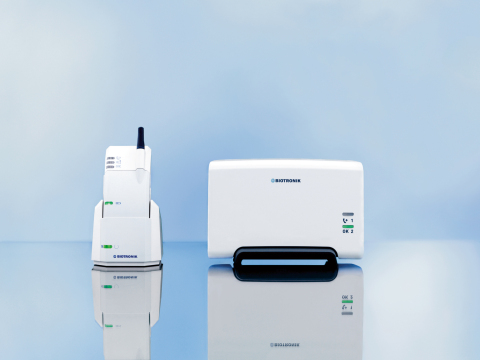New results published in Europace show newly developed short-duration atrial arrhythmias are associated with higher risk of thromboembolic events
BERLIN--(BUSINESS WIRE)--BIOTRONIK announced today the publication of "Detection of atrial high-rate events by continuous Home Monitoring: clinical significance in the heart failure-cardiac resynchronization therapy population" in Europace by Dr. Nesan Shanmugam et al.1 This analysis of data, pooled from two randomized, prospective, international, multicenter studies, showed that short-duration atrial high-rate events (AHRE) were significantly associated with a higher risk for thromboembolic events such as stroke. BIOTRONIK Home Monitoring®, with its capability of continuous monitoring-and FDA- and CE-approved early detection of clinically relevant events, including asymptomatic atrial arrhythmias-can support physicians with identifying these patients who are at a higher risk.
"We conducted this analysis because uncertainty has existed over the importance of device-detected, short-duration atrial arrhythmias," commented Professor Stefan Sack, Chair and Director, Department of Cardiology, Pneumonology and Intensive Care Medicine, Academic General Hospital Munich-Hospital Schwabing, Germany, and senior author of the publication. "Continuous atrial diagnostics conducted by the BIOTRONIK Home Monitoring® technology give us an opportunity to assess the frequency and duration of atrial fibrillation (AF) episodes defined as AHRE."
Data were analyzed from 560 heart failure (HF) patients with implanted cardiac resynchronization therapy (CRT) devices who were enrolled in two separate studies. Patients were divided into four groups based on whether or not they had a prior history of AF at study enrolment and whether or not they developed AHRE during the study follow-up period. To determine what duration of AHRE is associated with increased risk, the patients were later divided into three subsets based on the amount of AHRE (zero, low [below median] or high [above median]). AHRE burden was defined as the duration of mode switch in a 24-hour period due to atrial rates of more than 180 beats per minute. The primary endpoint was incidence of a thromboembolic event (stroke, transient ischemic attack, peripheral arterial embolism). Secondary endpoints were cardiovascular death and hospitalization because of AF or worsening HF. The mean study follow-up was 370 days.
"Most significantly," Sack continued, "this analysis found that patients with detected AHRE of more than 3.8 hours over 24 hours were at significantly higher risk, as they were 9 times more likely to develop thromboembolic complications and 4 times more likely to die from a cardiovascular cause compared to patients without AHRE."
"This study emphasizes the potential importance of constant monitoring of patients clinical status by devices with remote connectivity. Systems that rely on episodic interrogation or without appropriate alerts may delay recognition of risk situations by months," commented Dr. Vince Paul, Department of Cardiology, Royal Perth Hospital, Australia, and co-author of the paper.
The study results support a workflow where routine assessment of AHRE with BIOTRONIK Home Monitoring® should be considered with other data when determining stroke risk and planning anticoagulation initiation-and should also prompt the optimization of cardioprotective HF therapy in CRT patients. BIOTRONIK Home Monitoring® is a uniquely advantageous tool for enhancing patient care because it is the only remote management system that continuously monitors clinical and device status.
In order to investigate the clinical benefit of using the unique early detection capabilities of BIOTRONIK Home Monitoring® to guide anticoagulation therapy in ICD and CRT patients, BIOTRONIK is further sponsoring the landmark IMPACT trial2. With planned enrollment of more than 2,700 patients with an expected follow-up period of 36 months, IMPACT investigates whether the risk for stroke, systemic embolism and major bleeding can be reduced through initiation and withdrawal of anticoagulation therapy based on BIOTRONIK Home Monitoring® information.
"The IMPACT clinical trial may hold the key for improving patient outcomes with regards to reducing the risk of stroke with the unique early detection and continuous monitoring capabilities offered by BIOTRONIK Home Monitoring®," commented Dr. Werner Braun, Managing Director, BIOTRONIK. "The results of IMPACT have the potential to significantly change clinical practice and improve patient outcomes by effectively guiding clinical decision-making regarding anticoagulation therapy."
About BIOTRONIK Home Monitoring®
BIOTRONIK Home Monitoring® is the first and only remote patient management system with FDA and CE approvals for safe reduction of in-office follow-ups and for early detection of clinically relevant events, leading to earlier intervention, based on results of the TRUST landmark trial3-4. The system is unique because it allows continuous automatic wireless remote monitoring of patient and device status with daily updates, all independent from any patient interaction. BIOTRONIK Home Monitoring® has pioneered advances in remote patient management since its first clinical application in the year 2000. Today, BIOTRONIK Home Monitoring® is extensively used in a growing number of patients in more than 3,800 clinics and 55 countries worldwide.
About BIOTRONIK SE & Co. KG
As one of the world's leading manufacturers of cardiovascular medical devices, with several million devices implanted, BIOTRONIK is represented in over 100 countries by its global workforce of more than 5,600 employees. Known for having its finger on the pulse of the medical community, BIOTRONIK assesses the challenges physicians face and provides the best solutions for all phases of patient care, ranging from diagnosis to treatment to patient management. Quality, innovation and reliability define BIOTRONIK and its growing success-and deliver confidence and peace of mind to physicians and their patients worldwide.
More information: www.biotronik.com
References:
1 Shanmugam N et al., Europace 2011. doi:10.1093/europace/eur293.
2 Ip J et al., Am Heart J 2009; 158:364-370
3 Varma N et al., Circulation 2010, 122, 325-332
4 Varma N et al., Circ Arrhythm Electrophysiol 2010, 3:428-436
Upon publication, please provide us with a copy.
Photos/Multimedia Gallery Available: http://www.businesswire.com/cgi-bin/mmg.cgi?eid=50086772&lang=en
Contacts
BIOTRONIK SE & Co. KG
Sandy Hathaway
Senior Director, Global Communications
Tel. +49 (0) 30 68905 1602
Email: sandy.hathaway@biotronik.com

BIOTRONIK Home Monitoring - Stationary and Portable Device (Photo: Business Wire)




